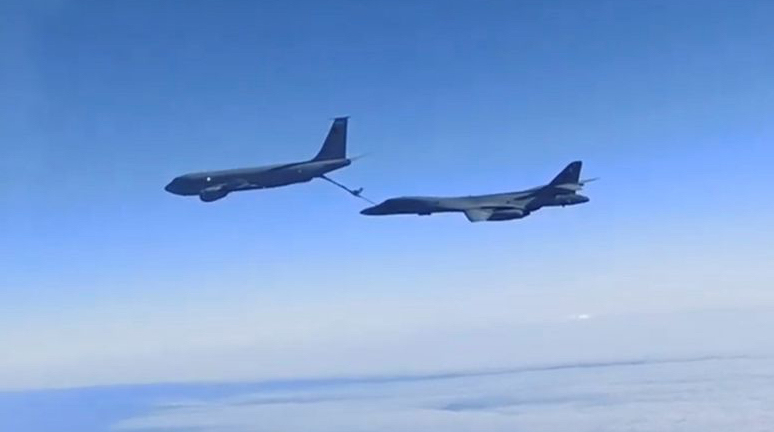A short clip filmed by one of the Russian Flankers show the B-1 during air-to-air refueling with a KC-135 over the Black Sea.
On Oct. 19, 2021, two B-1B Lancer bombers belonging to the 9th Expeditionary Bomb Squadron, currently deployed to RAF Fairford, UK, as part of Bomber Task Force Europe, executed a counter maritime mission in the Black Sea region.
During the mission, as they transited through the region and throughout the maritime targeting mission, the BONEs (as the B-1s are dubbed in the pilot community), using callsign “DARK” integrated with Romanian, Polish, and Canadian fighters, supporting the NATO Air Policing mission over Romania, and were also supported by RAF Mildenhall’s KC-135 Stratotankers and a Turkish Air Force KC-135.
Needless to say, as happened with similar sorties in the past, the segment flown over the neutral waters of the Black Sea was closely monitored by the Russian Federation air defence: in particular, two Black Sea Fleet Naval Aviation Su-30 Flanker derivates were scrambled to escort the two B-1s and two accompanying KC-135 tankers as they flew off Crimea.
The pilot of one of the Su-30s also filmed one of the B-1s as it was about to receive fuel from one of the Stratotankers (that looks like to be the Turkish one). The video was then released by the Russian MOD:
Unlike what happened during some famous “unprofessional” intercepts involving P-8s or B-52s, this clip shows the Su-30 remaining at safe distance from the BONEs as it approaches the tanker.
“Our forces are postured to respond to any threat, anywhere, anytime,” said Gen. Jeff Harrigian, USAFE-AFAFRICA commander in a public release. “BTF provides enhanced interoperability training with our allies and partners, building coalition strength, and bolstering our ability to respond to all threats with unmatched power.”
B-1B from Fairford (DARK Flt x2) taking fuel yesterday from 100th ARW KC-135 enroute to a Black Sea mission [USAF Pic by J Barron + ADSB Ex] #B1s #RAFFairford pic.twitter.com/cjRdEQV8M5
— Saint1 (@Saint1Mil) October 20, 2021
Unfortunately, no additional details about the mission were released this time. Last year, the United States Air Force in Europe (USAFE) command released an official statement about the focus of a mission flown in the last week of May 2020, when the B-1s flew to the Black Sea to train on the Long Range Anti-Ship Missile capability (a mission that, once again saw the BONEs be intercepted by Russian Su-30s). However, it seems quite likely that the B-1s were involved in a similar mission profile.
The AGM-158C LRASM, based on the AGM-158B Joint Air-to-Surface Standoff Missile – Extended Range (JASSM-ER), is the new low-observable anti-ship cruise missile developed by DARPA (Defense Advanced Research Projects Agency) for the U.S. Air Force and U.S. Navy. It has already been integrated on the B-1B Lancer and F/A-18E/F Super Hornet, with integration aboard the P-8 Poseidon and MK41 Vertical Launch Systems currently in the works. The B-1B can carry up to 24 AGM-158C missiles.









